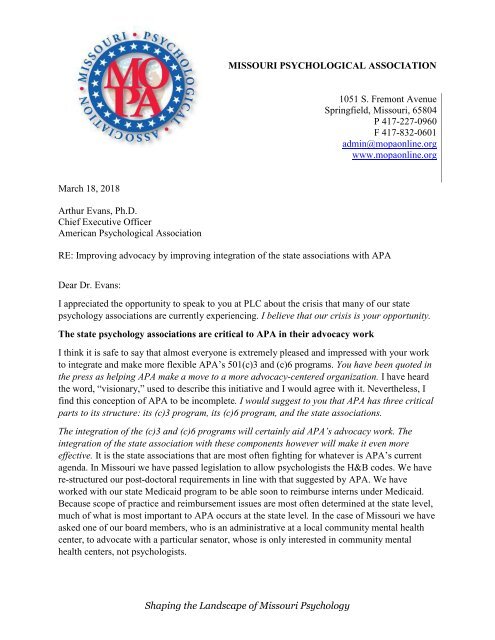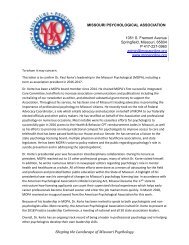MOPA 2018 Letter to Dr. Evans regarding STPAs
You also want an ePaper? Increase the reach of your titles
YUMPU automatically turns print PDFs into web optimized ePapers that Google loves.
MISSOURI PSYCHOLOGICAL ASSOCIATION<br />
1051 S. Fremont Avenue<br />
Springfield, Missouri, 65804<br />
P 417-227-0960<br />
F 417-832-0601<br />
admin@mopaonline.org<br />
www.mopaonline.org<br />
March 18, <strong>2018</strong><br />
Arthur <strong>Evans</strong>, Ph.D.<br />
Chief Executive Officer<br />
American Psychological Association<br />
RE: Improving advocacy by improving integration of the state associations with APA<br />
Dear <strong>Dr</strong>. <strong>Evans</strong>:<br />
I appreciated the opportunity <strong>to</strong> speak <strong>to</strong> you at PLC about the crisis that many of our state<br />
psychology associations are currently experiencing. I believe that our crisis is your opportunity.<br />
The state psychology associations are critical <strong>to</strong> APA in their advocacy work<br />
I think it is safe <strong>to</strong> say that almost everyone is extremely pleased and impressed with your work<br />
<strong>to</strong> integrate and make more flexible APA’s 501(c)3 and (c)6 programs. You have been quoted in<br />
the press as helping APA make a move <strong>to</strong> a more advocacy-centered organization. I have heard<br />
the word, “visionary,” used <strong>to</strong> describe this initiative and I would agree with it. Nevertheless, I<br />
find this conception of APA <strong>to</strong> be incomplete. I would suggest <strong>to</strong> you that APA has three critical<br />
parts <strong>to</strong> its structure: its (c)3 program, its (c)6 program, and the state associations.<br />
The integration of the (c)3 and (c)6 programs will certainly aid APA’s advocacy work. The<br />
integration of the state association with these components however will make it even more<br />
effective. It is the state associations that are most often fighting for whatever is APA’s current<br />
agenda. In Missouri we have passed legislation <strong>to</strong> allow psychologists the H&B codes. We have<br />
re-structured our post-doc<strong>to</strong>ral requirements in line with that suggested by APA. We have<br />
worked with our state Medicaid program <strong>to</strong> be able soon <strong>to</strong> reimburse interns under Medicaid.<br />
Because scope of practice and reimbursement issues are most often determined at the state level,<br />
much of what is most important <strong>to</strong> APA occurs at the state level. In the case of Missouri we have<br />
asked one of our board members, who is an administrative at a local community mental health<br />
center, <strong>to</strong> advocate with a particular sena<strong>to</strong>r, whose is only interested in community mental<br />
health centers, not psychologists.<br />
Shaping the Landscape of Missouri Psychology
The state associations are having difficulty maintaining their expertise<br />
Excellence has always been important <strong>to</strong> APA. We want our psychologists <strong>to</strong> be practicing at the<br />
<strong>to</strong>p of their licenses. Organizationally we want APA <strong>to</strong> be a model of excellence. When I testify<br />
at our state legislature, I speak of the need for access <strong>to</strong> expert mental and behavioral healthcare.<br />
And though we all wish the same for our state organizations, we do not always receive the<br />
attention and resources necessary <strong>to</strong> accomplish this, particularly the small and moderate<br />
associations. This is a shame. Because for many people in our individual states, the state<br />
association not APA, is the voice of psychology and what is meant by professional psychology.<br />
State associations are losing their expertise in four ways: 1) State association financial problems<br />
2) ED turnover 3) The replacing of full time EDs with part-time EDs, 4) Rapid board member<br />
turnover, and 5) Lack of support for PLC attendance.<br />
A large majority of our associations that are small <strong>to</strong> medium in size report that they are simply<br />
financially unstable. Last year alone we saw 30% turnover in our states’ executive direc<strong>to</strong>r<br />
positions. Many of our executive direc<strong>to</strong>rs are part-time employees with a limited understanding<br />
of the field of psychology, let alone having an understanding as <strong>to</strong> how APA works. One of the<br />
state association executive direc<strong>to</strong>rs works only one day a week. With each turnover, often<br />
prompted by financial problems, our state associations lose more and more of the expertise<br />
necessary <strong>to</strong> work with APA effectively and <strong>to</strong> promote psychology and APA’s agenda in their<br />
states.<br />
It is flattering <strong>to</strong> hear repeatedly that the state associations “are where the rubber meets the<br />
road.” But there is little discussion as <strong>to</strong> what resources our associations’ need or how they best<br />
might be structured <strong>to</strong> meet this lofty expectation. The tremendous pace of the turnover of state<br />
association executive direc<strong>to</strong>rs undercuts CESPPA’s ability <strong>to</strong> effectively organize any<br />
thoughtful advocacy with APA or <strong>to</strong> be able <strong>to</strong> educate APA on associations’ needs. A majority<br />
of the emails on the CESPPA listserv is about saying hi <strong>to</strong> new EDs, good-by <strong>to</strong> old ones, and<br />
educating the new EDs <strong>regarding</strong> <strong>to</strong> how the system works.<br />
Another contributing fac<strong>to</strong>r is the rapid turnover of association board members. Small<br />
associations do not typically have the committee structure <strong>to</strong> help buffer the additional loss of<br />
expertise that occurs because of this. With increased contributions expected from associations in<br />
order <strong>to</strong> attend PLC, we are now seeing associations send less members <strong>to</strong> the conference, which<br />
impairs the transfer of knowledge about APA. Even one of the larger associations informed that<br />
they were unable <strong>to</strong> afford <strong>to</strong> send their executive direc<strong>to</strong>r this year.<br />
Greater direct financial support would clearly help, but APA could also be helpful in better<br />
promoting membership in the state associations <strong>to</strong> its current members. APA could also<br />
purchase advertising for its products from the state associations or act as sponsors <strong>to</strong> our state<br />
conferences. It would provide speakers <strong>to</strong> our conferences at no cost. It could reduce the costs<br />
and fees <strong>to</strong> participate in PLC.<br />
Difficulty staying connected <strong>to</strong> APA<br />
Relationships are the key <strong>to</strong> any effective business operation. When executive direc<strong>to</strong>rs are new<br />
and have a short tenure, they are constantly trying <strong>to</strong> understand their own state organization, let<br />
alone their more complex connection with APA. This makes it hard <strong>to</strong> use APA as a resource<br />
and <strong>to</strong> be a resource <strong>to</strong> APA.<br />
Shaping the Landscape of Missouri Psychology
Recognition of the state associations within APA needs <strong>to</strong> be ongoing<br />
This is a difficult issue <strong>to</strong> address. I am personally very grateful for the support the CAPP grants<br />
offer our association. I appreciate the guidance and expertise Susie Lazaroff and Dan<br />
Abrahamson and various offices within APA provide. Nevertheless, I believe that we are<br />
somewhat invisible <strong>to</strong> APA as a whole, particularly on a daily basis. We are not part of the<br />
organizational charts. And as we all know, organizational charts are a clear indica<strong>to</strong>r of in and<br />
out groups. They define the relationships and relative rank and authority and power between the<br />
various parts of an organization. If the state associations are truly a critical part of APA, they<br />
should be represented in some fashion on the organizational chart <strong>to</strong> inform those working<br />
within APA of the state association’s importance. This could be done by including CESPPA in<br />
any organizational chart.<br />
There was an interesting absence at PLC this year. There were no shout-outs for the most part<br />
with what various individuals and associations had accomplished that was special this year.<br />
These shout-outs were usually done by <strong>Dr</strong>. Nordal, who had a lesser role in the conference this<br />
year and who rightfully needed time <strong>to</strong> say good-by <strong>to</strong> all of us. I do appreciate the recognition I<br />
personally received from Division 31 this year, but there were likely a lot of association heroes<br />
who were left unrecognized. It is difficult for those who are unrecognized <strong>to</strong> make significant<br />
contributions.<br />
State associations need a clearer and more consistent voice within APA<br />
If our diversity groups have taught us anything, it is the importance of listening for the voice that<br />
has not been heard. If APA is <strong>to</strong> truly represent all psychologists, it should encourage a more<br />
bot<strong>to</strong>m-up agenda and listening style, starting arguably with the needs of its state associations.<br />
We appreciate the recent council move inititated by Peter Oppenheimer, our own Kenneth Baum,<br />
and xxx <strong>to</strong> guarantee each association a spot on the APA council.<br />
NASW introduces new model connecting their national and state organizations<br />
NASW is now funding office costs, staff salaries, and website costs. It is unclear how much<br />
au<strong>to</strong>nomy state offices will have in the future. A portion of all membership funds collected by<br />
NASW can be shared with the state offices, though some state offices find themselves losing<br />
funds.<br />
Summary of suggestions<br />
• Recognize the state associations as structurally a critical part of APA, in the same way we<br />
recognize the (c)3 and (c)6 components.<br />
• Determine what excellence would be at the state level.<br />
• Have a clearer plan <strong>to</strong> help protect the expertise that exists at the state association level<br />
and help the associations become more financially stable. There are numerous direct and<br />
indirect ways that APA could assist the state associations financially and <strong>to</strong> help them<br />
grow membership. Consider sharing APA revenue with the states. Some states may have<br />
<strong>to</strong> develop a (c)3 component <strong>to</strong> help make this work.<br />
• Include CESPPA and the state associations in your organizational charts and involve<br />
them more in APA’s planning and decision-making activities. Collaboration almost<br />
always produces better results.<br />
Shaping the Landscape of Missouri Psychology
• Give the state associations, particularly through CESPPA, a clearer and more consistent<br />
voice and encourage a more bot<strong>to</strong>m-up agenda.<br />
I appreciate your support and hope that those of us working our state associations can take a<br />
more active role in shaping APA’s future success.<br />
Respectfully,<br />
Chuck Hollister, Ph.D.<br />
Chief Executive Officer<br />
Licensed Psychologist<br />
Missouri Psychological Association<br />
Shaping the Landscape of Missouri Psychology



